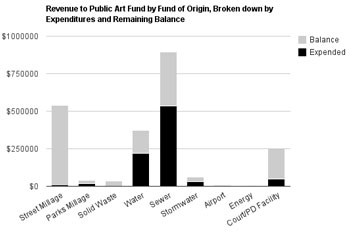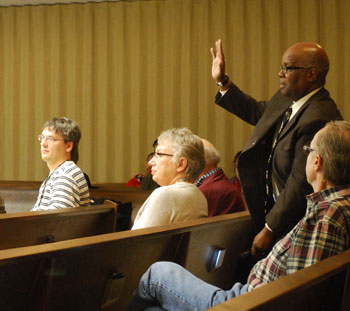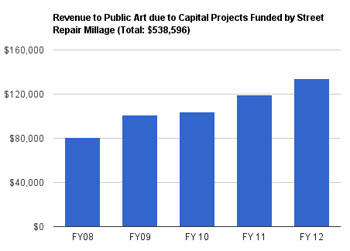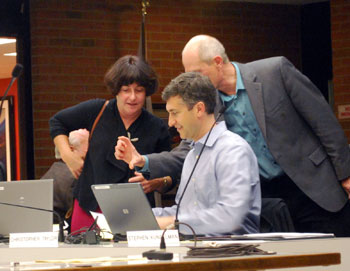Council Preview: Public Art Ordinance
After holding a Nov. 14, 2011 work session on public art, the Ann Arbor city council will take up a proposed revision to the city’s ordinance on public art at its Nov. 21 meeting. The city’s Percent for Art program, supported by the local law, currently stipulates that 1% of the budget for any capital improvement project in the city (up to a $250,000 limit) be set aside for public art.

Revenue to public art by fund, broken down by expended amounts and remaining balance. The black portion of the bars represents expenditures to date. The gray portion of the bar represents remaining balance. The overall height of the bar corresponds to total revenues to the public art fund from a particular origin fund. (Chart by the Chronicle. Image links to a higher resolution file.)
The proposed amendments to the public art ordinance were first considered by the council at its Sept. 19, 2011 meeting, with action postponed until Nov. 21. Key features of the amendment include: (1) exclusion of projects funded by street repair millage funds from the ordinance requirements; (2) addition of requirements that would return public art money to its fund of origin, if not expended within a specific time frame; (3) explicit exclusion of general fund dollars from ordinance requirements.
At the Nov. 14 work session, Sue McCormick – the city’s public services area administrator – provided city staff recommendations to the council that implicitly responded to the main elements of the currently proposed ordinance amendments. While specific mechanisms and alternatives for implementing (2) and (3) were provided, a general recommendation was made against narrowing the base of funding streams for public art, as (1) would do.
Staff recommendations also included a suggestion to increase the value of the contract for the public art administrator (not currently a city employee) by up to $35,000 a year.
Any changes the council makes to the ordinance on Nov. 21 will receive only initial approval. It’s possible that on Nov. 21, the council could consider approaches to amending the public art ordinance that are different from those currently proposed. For example, in the past, the council has contemplated, but rejected, a simple reduction in the amount of funding – from 1% to 0.5%.
Background: Past History of Attempted Revisions
By way of background, the public art ordinance has been somewhat controversial since its approval in 2007. [.pdf of ordinance text as approved on Nov. 5, 2007] As far back as Feb. 1, 2009 at a council Sunday caucus, Marcia Higgins (Ward 4) publicly expressed her concern about the large amount of money the program was generating.
Later that year, at a Dec. 7, 2009 meeting, the council gave initial approval to an ordinance revision that would have reduced the allotment from 1% to 0.5%. But at the council’s following meeting, on Dec. 21, 2009, the council voted down the ordinance revision, with councilmembers citing art as key to Ann Arbor’s identity.

Ann Arbor public art commissioner Malverne Winborne waves to the council as members of the commission are introduced. Seated in front of Winborne is Margaret Parker. In the next row up (striped shirt) is Aaron Seagraves, the city's public art administrator.
The legality of the program has been questioned by Stephen Kunselman (Ward 3), because it taps funds that are restricted in their use – dedicated millage funds, and funds that receive revenue from fees. Kunselman has repeatedly asked that the city attorney make public an opinion that would provide a legal basis for the use of restricted funds for the public art program. Kunselman has cited a city charter requirement that such opinions be made public. To date, city attorney Stephen Postema has declined to provide a written opinion for public inspection.
Most recently, in connection with approval of the fiscal year 2012 budget in May 2011, Higgins brought forward a budget amendment that would have directed the city attorney to prepare an ordinance amendment to reduce the percentage in the public art ordinance from 1% to 0.5%. That attempted amendment failed on a 4-7 vote, with support only from Higgins, Kunselman, Sandi Smith (Ward 1) and Sabra Briere (Ward 1).
The outcome of the Ward 2 city council election two weeks ago, in which Stephen Rapundalo was defeated by Jane Lumm, could start to shift the balance in favor of some kind of ordinance revision. During the campaign, Lumm was critical of city expenditures made on public art during difficult economic times, and Rapundalo was adamant in his support of the program. Margaret Parker, a public art commissioner who was instrumental in starting the Percent for Art program, actively encouraged support of Rapundalo over Lumm.
Background: Context of Current Attempt at Revisions
The currently proposed amendment to the ordinance was first considered by the council at its Sept. 19, 2011 meeting, but postponed at that meeting until the council’s second meeting in November – Nov. 21. The most recent round of city council debate on the public art ordinance actually got a quiet start earlier than Sept. 19 – at the council’s Aug. 4, 2011 meeting.
Before the Aug. 4 meeting, some councilmembers were prepared to debate the issue in the context of the street and sidewalk repair tax questions, which the council voted that night to place on the Nov. 8 ballot. [Both the renewal of the 2.0 mill street repair tax and the new 0.125 mill sidewalk repair tax were approved by voters.]
At the start of the Aug. 4 meeting, however, mayor John Hieftje announced that he’d be nominating Tony Derezinski (Ward 2) to serve on the public art commission as a replacement for recently resigned commissioner Jeff Meyers. Hieftje went on to say that in September he wanted to take a longer look at the city’s public art program. That announcement effectively headed off the possibility that the council would contemplate ballot language that would exclude those street/sidewalk repair tax revenues from the requirement of the public art ordinance.
Amendment: Street/Sidewalk Millage
Instead of handling the use of the street/sidewalk repair tax revenues in the ballot language that voters approved on the millage, the council is now contemplating a revision to the public art ordinance that would exclude those millage funds from the requirements of the public art ordinance.
Some councilmembers had previously understood the public art ordinance already to exclude replacement of sidewalk slabs from its definition of capital improvement projects.
But based on additional information from the city attorney’s office, the proposed ordinance revision is meant to spell that out explicitly [added language in italics]:
Capital improvement project means any construction or renovation of any public space or facility including buildings, parks, recreation areas, parking facilities, roads, highways, bridges, paths, sidewalks in locations where sidewalks do not already exist or as part of a larger capital improvement project, streetscape improvements and utilities. This definition includes only those projects designed to create a permanent improvement or betterment, and does not include projects that are primarily for the purpose of ordinary maintenance or repair. It does not include sidewalk crack repair, sidewalk cold-patching, sidewalk slab replacement, sidewalk leveling or sidewalk slab grinding. [.pdf of red-lined version of proposed ordinance revision]
An additional amendment to the ordinance would exclude the use of street repair millage funds (as well as general fund dollars) for public art projects under the ordinance [added language in italics]:
1:833. Art funding requirements for capital improvement projects.
(1) Except as otherwise provided in this section, all capital improvement projects funded wholly or partly by the city shall include funds for public art equal to 1% of the construction costs identified in the initial project estimate, up to a maximum of $250,000.00 per project. …
… (4) The requirements of subsection (1) of this section shall not apply to a capital improvement project or to a portion of a capital improvement project funded with funds from the city’s general fund or with funds from the 2012 Street and Bridge Resurfacing and Reconstruction and Sidewalk Repair Millage.
Since 2008, the public art ordinance has required that a total of $538,596 be set aside from capital improvement projects using street repair millage funds. Of that amount, only $9,344 has been expended, $8,059 of it on administration of the public art commission.

Revenue by year to public art fund due to capital projects funded by the street repair millage. For the five years, the total is $538,596. (Image links to higher resolution file.)
During her successful election campaign, Jane Lumm (Ward 2) pointed to the accumulation over the last five years of $538,596 in public art funds from the street repair millage as roughly comparable to the $563,000 that the sidewalk repair millage is projected to generate, and she questioned the need to levy a sidewalk millage. She suggested that the city could take on the responsibility for sidewalk repair, which up to now has been the responsibility of adjacent property owners. In that context, it’s worth noting that the $538,596 for public art has accumulated over the course of five years, whereas the sidewalk repair millage is expected to generate $563,000 each year.
Sue McCormick, the city’s public services area administrator, explained at the Nov. 14 work session that the staff recommended the city maintain a broad funding base for public art, which is an implicit recommendation against the ordinance revision excluding the street millage. In connection with that recommendation, McCormick pointed out that the use of the funds is already fairly restricted [from McCormick's PowerPoint slide]:
Maintain a broad base of source funds for public art:
- Public Art is restricted by the requirement to create a ‘permanent improvement’
- Public Art is restricted to be located in public spaces or facilities
- Public Art must be related to the purposes of the (originating) fund
McCormick explained at the work session that if the funding base were eventually narrowed to, say, just the water utilities fund, the city could find itself in a situation where the only public art projects that would be possible are those projects located at water facilities or that have water themes.
Amendment: Sunset Provision
It’s partly due to the fact that virtually no public art has yet been created out of funds accumulated from the street repair millage that has made the street repair millage a target for exclusion from the ordinance.
But at the Nov. 14 work session, Marsha Chamberlin – current chair of the Ann Arbor public art commission – described one way the street repair millage money might be spent on public art. She suggested the possibility of eventually using street millage funds set aside for public art by commissioning artists to create pavement marking for crosswalks and bike lanes, citing examples of this approach in Boston and Philadelphia. The PowerPoint presentation given at the council’s work session included an image of a crosswalk in Boston. [Examples of crosswalk art from: Boston, Washington D.C., Curitiba, Brazil, and in several other cities by the same artist, Roadsworth.]
Part of the proposed revision to the public art ordinance that the city council will take up on Nov. 21 addresses the issue of the accumulation from the street repair millage (with no investments yet in public art) without targeting that fund specifically. Instead, the amendment to the ordinance would require that the funds be spent on public art within three years, or else be returned to their fund of origin, whatever fund it is.
1:835. Disbursement of public art funds.
…
(4) Funds for public art in a pooled public art fund that have not been disbursed or encumbered for an art project for three (3) full fiscal years shall be returned to the fund of origination.
The staff recommendation presented at the Nov. 14 work session was essentially supportive of this part of the ordinance revision – if the provision were made that the city council could grant a two-year extension at the request of the public art commission. That kind of extension, said McCormick at the work session, would provide flexibility for unforeseen circumstances and project delays, and would be consistent with other parts of the city code that allow for extensions to be made with authorization from the council.
Based on discussion at the Oct. 26, 2011 meeting of the public art commission, when commissioners prepped for the council work session, the three-year sunset was not agreeable to all commissioners, but the two-year extension option made them more favorably inclined towards it.
Amendment: General Fund Exclusion
Under the proposed revision to the ordinance to be considered by the council on Nov. 21, not only street millage funds but also money from the city’s general fund would be explicitly excluded from the public art ordinance requirements.
The general fund is what pays for basic city operations – everything from police and fire protection to parks to the city clerk’s office. The main source of revenue for the general fund is the city’s general operating millage, which is levied at a rate of just over 6 mills.

Jane Lumm (Ward 2), mayor John Hieftje (standing) and Christopher Taylor (Ward 3) before the Nov. 14 work session. The session was Lumm's first occasion to participate in a gathering of the council as a newly elected councilmember, though she previously served on council in the 1990s. Taylor and Hieftje supported Stephen Rapundalo against Lumm in his re-election campaign.
From a practical point of view, it’s apparently a moot point. As McCormick pointed out at the council’s work session, the city’s general fund is not typically tapped for capital projects. To the extent that it would be, she said, it would be in the form of a one-time expenditure or a draw on the fund reserve balance and would thus not impact ongoing operations. To date, public services area records show only $13.50 has been spent on public art from the general fund. The general fund makes up around $80 million in a total city budget of over $300 million.
During the Ward 2 election campaign, the nearly zero amount of money drawn out of the general fund led Stephen Rapundalo to characterize the public art program as “budget neutral.”
But during the campaign, Lumm made the point that the fund for the municipal center construction project (aka the police/courts building) was established in part using general fund money, and the financing plan for the project’s bond payments uses money previously earmarked for the general fund. Fees from cell phone companies leasing spaces for antennas from the city came to $350,000-plus a year back in 2008. However, the financing plan for the municipal center called for using the antenna revenues for bond payments instead of depositing that money into the general fund. [.pdf of Ann Arbor News article, March 11, 2008: "Bonds, Cash to Fund Most of $47 million Project"]
At the work session, McCormick suggested two ways the council could deal with the general fund issue through ordinance revision if it were so inclined – it could either prohibit use of general fund money for public art under the ordinance, or else provide a way to exclude general fund money subject to the council’s consideration on a case-by-case basis.
Recommendation: Increased Staff Support
At the Ann Arbor public art commission’s Oct. 26, 2011 meeting, commissioners identified a lack of city staff support as causing an unreasonable burden for them, which had consequences for the pace at which public art could be commissioned and created. At the Nov. 14 work session, McCormick also explained that providing project oversight was not a role consistent with that of other boards and commissions of the city. It essentially amounted to commissioners acting as their own staff.
McCormick conveyed to the city council a recommendation that would increase the value of the contract – by $35,000 – for the city’s public art administrator, who is not a city employee. Currently that contract is with Aaron Seagraves, who took the job in May 2011. Previously, the part-time position had been vacant for almost a year, after Katherine Talcott, who was hired in early 2009, took the job of art project manager for the city. Seagraves currently has a one-year contract for 20 hours per week. At the Nov. 14 work session, McCormick characterized the proposed $35,000 increase to the contract as bringing it to essentially a full-time position.
At the work session, McCormick alluded to an 8% limit on administrative costs – the costs associated with the functioning of the commission itself (for example, keeping meeting minutes, among other items). [The 8% limit is not a part of the public art ordinance. By way of comparison, the city's greenbelt program operates under the legal limit of a 6% cap on administrative costs, though it has expended considerably less than that.] The 8% limit would still be in effect for public art administrative costs, McCormick explained.
The additional $35,000 would go towards project management. Currently, she said, project management for larger projects is provided by contract or assignment and paid as part of a project. However, for smaller projects – like the mural program – the work of managing projects has fallen to commissioners. It’s the project management of smaller projects that the additional $35,000 would cover, McCormick said.
The city’s public services area records show revenues to the public art administrative account of $165,480 through the end of fiscal year 2011, against only $73,122 in expenditures, leaving a $92,357 balance. So far this year (FY 2012) the public art administrative account shows $42,443 in revenue against just $4,139 in expenditures for a balance of $38,303.
Possible Council Action: Analysis
One possibility that the council might pursue on Nov. 21 is to consider the entire set of revisions currently proposed to the city’s public art ordinance and vote them up or down as a set. That’s unlikely, given the council’s past pattern and practice.
More likely is that councilmembers would select from the three key elements reflected in the revisions that they want to enact: (1) exclusion of projects funded by street repair millage funds from the ordinance requirements; (2) addition of requirements that would return public art money to its fund of origin, if not expended within a specific time frame; and (3) explicit exclusion of general fund dollars from ordinance requirements.
In the staff recommendations presented at the work session, there seemed to be little enthusiasm for singling out specific funds for exclusion from the program. If that sentiment is shared on the council, then it’s (2) – the sunsetting provision – that is most likely to survive and be advanced to a second reading before the council.
Another possibility that would be consistent with the staff recommendation not to shrink the breadth of funding support would be to reduce the percentage allocated to public art from 1% to 0.5% – an approach the council has considered but rejected in the past.
In any case, whatever the council might approve on Nov. 21 would need a second and final approval at a subsequent meeting, after a formal public hearing, during which an unlimited number of people are allowed to speak. The requirement of two readings and a public hearing applies to any ordinance revision.
The council has a historical practice of not allowing public commentary at its meetings that are designated as “working sessions.” However, at the Nov. 14 work session, the council departed from that practice by providing a slot on the working session agenda for it. Other than the listing on the agenda, it’s not clear that the provision of the unusual opportunity for public participation was publicized in advance. No one spoke during that opportunity.
Although a public hearing would eventually be required if the council gives the ordinance revision initial approval at the Nov. 21 meeting, the council is likely to hear from the public on the issue during the Nov. 21 meeting as well.
For every council meeting, 10 slots are available for public participation at the start of the meeting if reserved in advance by calling the city clerk (734.794.6140). Participation is also allowed, with no advance sign-up, near the conclusion of the meeting. Priority for reserved slots is given to people who would like to address an item on the council’s agenda.
In the past, several supporters of the Percent for Art ordinance have spoken during public commentary at council meetings when ordinance revisions have been considered. So it’s likely that a number of people will sign up for one of the 10 reserved slots at the start of the council meeting to address the issue of the public art ordinance revision.
Update: The proposed amendment was made the subject of a proposed revision on Friday, Nov. 18. Attached to the city’s online Legistar agenda is an alternative amendment that would reduce the amount of city funding from 1% to 0.5% – just for the period from July 1, 2012 to June 30, 2015. [.pdf of originally proposed ordinance amendment] [.pdf of possible revision to the ordinance amendment] The revised amendment would not, as the original amendment does, exclude the street repair millage fund from use for public art. However, in the revised amendment, the definition of capital improvement project would still exclude sidewalk repair.
The Chronicle could not survive without regular voluntary subscriptions to support our coverage of of publicly-funded programs like the Percent for Art, which is overseen by the Ann Arbor public art commission. Click this link for details: Subscribe to The Chronicle. And if you’re already supporting us, please encourage your friends, neighbors and colleagues to help support The Chronicle, too!




I feel like one of those little clockwork figures that pop out when the clock chimes, except for me it is the Percent for Art program. Ding! Ding!
The council has gotten its ankles tangled up a bit in its effort to do some fancy footwork. As the Chronicle noted in a recent column [link], the ordinance attempts to link art to a function in a sometimes confounded way. (This was presumably to justify using public funds that were assessed to fill a function.) The idea about the crosswalk art is an example of this. I like pretty crosswalks too, and the example I clicked on looks nice. But is it art?
As I tried to discuss in a recent blog post [link], the proponents of this measure are big on symbolism about Art and also about its supposed value as an economic development tool. But it seems that more and more the choices being made are for decoration, not Art. Admittedly, my qualifications for discussing Art are a liberal arts education and a very fine drawing of a dissected lobster. Still, I doubt that the chance visitor to Ann Arbor is going to inhale deeply upon viewing our decorative crosswalks and declare: “Ann Arbor has a soul for Art and I want to relocate here!”
The unrelentingly narrow vision of those who support this program astonishes me.
Again, let’s have Council vote to direct the City Attorney to provide a written opinion on the legality of the program.
If Marcia Higgins, Steve Kunselman, Sandi Smith and Sabra Briere, Mike Anglin and Jane Lumm support that measure, it passes.